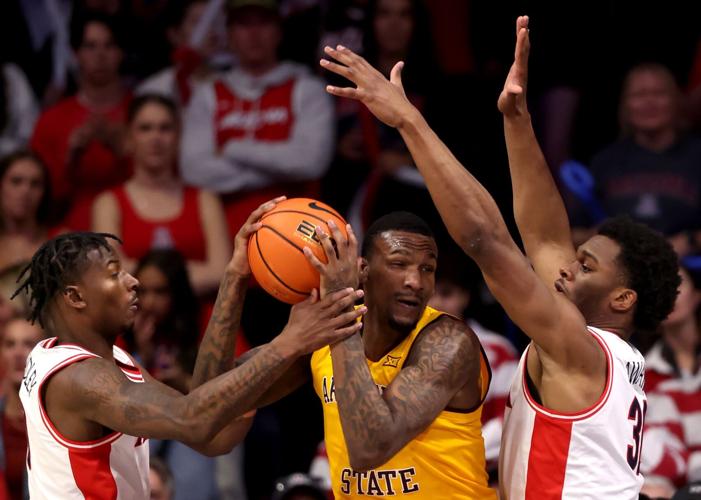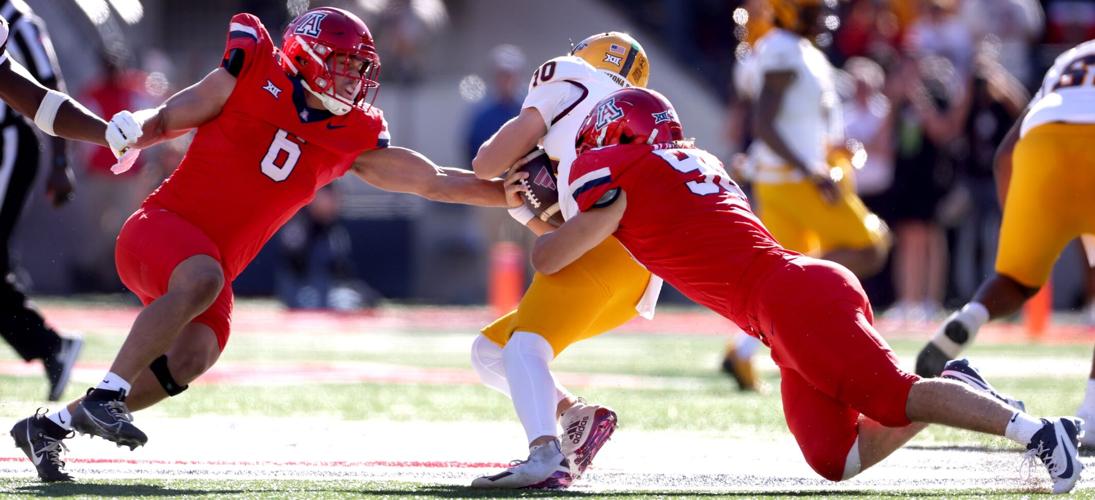Ground zero for the new era of college sports is a 100-mile stretch of interstate in the Sonoran Desert. Which school, Arizona or Arizona State, will thrive in the era of revenue share and legitimate NIL? The outcome will reveal much about the competitive balance within the state and across major college sports.
Do campuses in major cities possess an advantage?
How might market competition from professional sports impact success?
Will high-profile basketball programs undercut football success?
The Sun Devils and Wildcats are bitter rivals competing in the same conference and the same (public) university system, but their locations and resources are wildly different.
Nowhere else is the contrast as stark.
UCLA doesnŌĆÖt have a UC system rival located in a college town.
People are also reading…

Arizona linebacker Taye Brown (6), left, and linebacker Lance Keneley (90) meet at Arizona State quarterback Sam Leavitt (10) for a sack in the first quarter of their Big 12 football game, the 98th Territorial Cup in ┤¾Ž¾APPon Nov. 30, 2024.
Washington and Washington State arenŌĆÖt in the same conference or university system.
Georgia and Georgia Tech might be roughly comparable if their locations were flipped.
New York City, Philadelphia and Dallas are devoid of public universities that compete in the Power Four. Houston is bigger than Phoenix, but the Cougars donŌĆÖt have a bitter natural rival in the Big 12.
The dynamics in Arizona will unfold against an established backdrop: Fair or not, the Sun Devils are considered an underachiever in major college football and basketball; the Wildcats are viewed as an overachiever.
But that backdrop seemingly has little relevance in the new era. The House vs. NCAA lawsuit settlement ŌĆö former ASU swimmer Grant House is the named plaintiff ŌĆö will change the economics of college sports like nothing else.
Two pillars are particularly relevant for the Sun Devils and Wildcats:
ŌĆö Schools can share up to $20.5 million with athletes beginning in 2025-26. Across the power conferences, roughly $15 million will be earmarked for football, with $3.5 million to $4.5 million to menŌĆÖs basketball and the rest to Olympic sports. (The Big 12 will permit schools to allocate as they see fit.)
ŌĆö The power conferences created an NIL clearinghouse designed to eliminate the pay-for-play anarchy that has existed during the recent era of booster-run collectives. Athletes are now required to report NIL deals of $600 or more. A technology platform, NIL Go, will assess whether the contract terms fall within a reasonable range of compensation. Deals that are initially rejected can be altered and resubmitted, or the athlete can choose arbitration.
How might those factors play out in ┤¾Ž¾APPand Tempe? Where does the advantage lie?
Clearly, the Sun Devils will have more opportunities for legitimate NIL deals in metropolitan Phoenix (population: 5 million) than Arizona athletes will in ┤¾Ž¾APP(1 million).
But the Sun Devils also have more competition for dollars and attention with the Diamondbacks, Cardinals, Suns and Mercury.
In Tucson, all eyes are on the Wildcats. ThereŌĆÖs only one option for businesses seeking exposure through partnerships with sports teams or franchises.

Arizona guard Jaden Bradley (0), left, and forward Tobe Awaka (30) try to keep Arizona State from putting up a shot under the basket in the second half of their Big 12 game in ┤¾Ž¾APPon March 4, 2025.
But thatŌĆÖs just one piece of the broader calculation in the post-House world.
Arizona will undoubtedly feel compelled to allocate more revenue to its menŌĆÖs basketball program than the average power conference school. Every dollar plowed into basketball could be one less dollar available for football.
Kansas, UCLA, Kentucky and North Carolina are in similar positions. Arizona State is not. The Sun Devils have always valued football above basketball and seemingly can share the maximum with coach Kenny DillinghamŌĆÖs roster.
ŌĆ£(Power Four) schools where basketball is king are going to have to make an important choice under the House settlement terms,ŌĆØ sports attorney Mit Winter wrote on the social media platform X.
We donŌĆÖt know the specifics, but itŌĆÖs easy to envision ASU spending $1 million-to-$2 million more on football than the Wildcats. (One thing they have in common: Both schools must fund baseball at a competitive level, which isnŌĆÖt the case for some schools in the Big 12.)
Will the elite basketball programŌĆÖs lofty status undercut resources for Arizona football?
Will the passion of a college town in the era of legitimate NIL trump the big business opportunities that exist in a pro sports market like Phoenix?
And how will the internal dynamics play out? Will the schools continue to subsidize their athletic departments at current levels? How committed to success is longtime ASU president Michael Crow? What about new Arizona president Suresh Garimella?
If the campus-level commitments are equivalent, the Wildcats and Sun Devils could offer an unfiltered look at the new world order ŌĆö at the role fan passion, competitive priorities and business communities will play in shaping the roster-building process.
Will the big-city schools gain an insurmountable advantage?
Or does the edge lie with the only thoroughbred in a one-horse town?
Bitter rivals in the Big 12 could offer a fascinating test case for success in the post-House world.


















